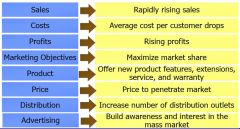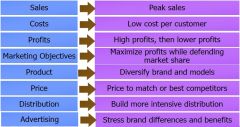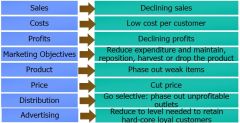![]()
![]()
![]()
Use LEFT and RIGHT arrow keys to navigate between flashcards;
Use UP and DOWN arrow keys to flip the card;
H to show hint;
A reads text to speech;
24 Cards in this Set
- Front
- Back
|
new product development definition |
development of original products, product improvements, product modifications, new brands through firm's own R&D efforts |
|
|
new product development strategy |
can be obtained via acquisition or development new products suffer from high failure rates |
|
|
how to obtain new product ideas? |
acquired companies, patents, licenses original products, product improvements, product modifications, new brands |
|
|
causes of new product failures |
as many as 80% of new consumer packaged products failed overestimation of market size, product design problems, incorrectly positioned, priced or advertised, product may have been pushed despite poor marketing research findings, costs of product development, competitive actions |
|
|
how to improve new product success? |
unique superior product, well-defined product concept understand customers, markets and competitors develop products that deliver super value to customers |
|
|
major stages in new product development |
idea generation -> idea screening -> concept development and testing -> marketing strategy -> business analysis -> product development -> test marketing -> commercialization |
|
|
step 1: idea generation |
systematic search for new product ideas obtained internally also from customers, competitors, distributors, suppliers crowdsourcing |
|
|
step 2: idea screening
|
product development costs increase dramatically in later stages ideas are evaluated against criteria, most eliminated |
|
|
criteria for rating and screening ideas
|
market size, product price, development time & costs, manufacturing costs, rate of return evaluated further against set of general company criteria |
|
|
step 3: concept development |
develop new product ideas into alternative detailed product concepts test new product concepts with target customers choose one that has strongest appeal to target customers |
|
|
3 part process of step 4: marketing strategy |
1. overall: target market, planned product positioning, sales & profit goals, market share 2. first year: product's planned price, distribution, marketing budget 3. long term: sales & profit goals, marketing mix strategy |
|
|
step 5&6: business analysis, product development |
business analysis: sales, cost and profit projections, look at sales history of similar products and conduct surveys of market opinion product development: prototype development and testing |
|
|
step 7: test marketing |
where the product and marketing program are introduced into more realistic market settings |
|
|
elements that may be test marketed by companies |
product, positioning, advertising, distribution, pricing, branding, packaging, budget levels |
|
|
what kind of test market can they use? |
standard test market - full campaign in small number of representative cities controlled test market - few stores that agreed to carry new products for a fee simulated test market - test in simulated environment to sample of consumers |
|
|
step 8: commercialisation |
introduction of new product into marketplace when is the right time, where to launch |
|
|
product life cycle graph |

|
|
|
problems arising from using PLC |
trouble identifying which stage product is in difficult to forecast sales level, length of each stage, shape of PLC strategy is both cause and result of product's life cycle |
|
|
product development of PLC |
begins when company develops new-product idea sales are zero investment costs are high negative profits |
|
|
introduction stage of PLC |

c
|
|
|
growth stage of PLC |

|
|
|
maturity stage of PLC |

|
|
|
strategies for maturity stage of PLC |
bring price down, introduce more functions at the same price build on USP modify the market - increase consumption of current product modify product - changing characteristics (quality, features, styles) modify marketing mix - improve sales by changing one or more marketing mix elements |
|
|
decline stage of PLC |

|

